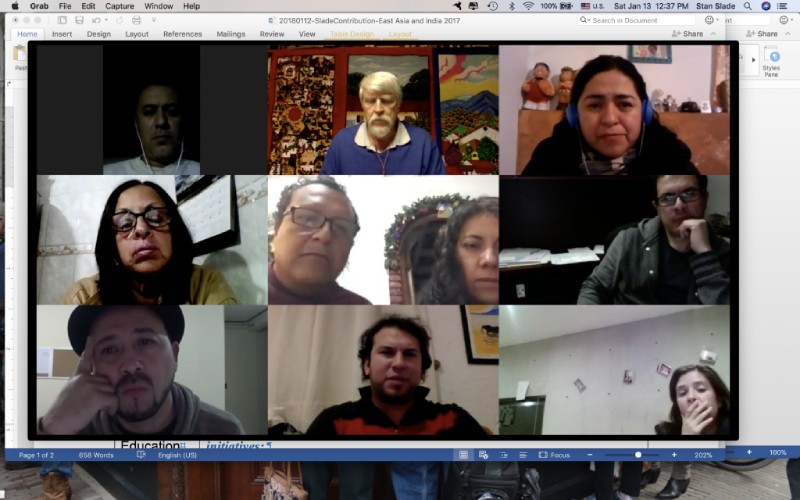
“¡Nos virtualiveremos, profe!”
Come again?
It totally caught me by surprise and made me laugh. If you speak Spanish, you can easily figure it out, even though that certainly is not standard Spanish!
In standard Spanish, one of the many ways to say “so long ‘til next time” is the parallel to our English, “See you later,” or “See you!” It is “¡Nos veremos!”—literally, “we will see each other.” (It is hard to resist the temptation to digress on the values embedded in this simple difference!)
As you have guessed by now, regardless of Spanish ability, “¡Nos virtualiveremos!” is “see you virtually!”
So, I am learning some new language. But that is by far the tiniest piece of it. After over forty years of teaching in classrooms (and under trees, and… and…), for the first time in my life I am teaching a class entirely online. I have often used cyberspace to enrich the content available for face-to-face courses over the years. But this, this is an entirely different animal. I feel like I have had to go back to square one.
In the early seventies I got introduced to a highly participatory way to do Bible study, loved it and began to practice it whenever possible in informal learning situations. By February of 1980, during my first year as a college professor, I came to see that active engagement with students through dialogue was the only way I really wanted to teach. Don’t get me wrong, I love a well-crafted lecture. I still remember being enthralled by the best lecturers at Stanford and at Fuller. I have loved listening to my friends who are great lecturers. And, judging by what has become the global phenomenon of “TED talks,” there are tons of us who love a great presentation! But when it comes to the midwifery of assisting adult learners to expand their knowledge and deepen their understanding, I am all about engagement and dialogue.
But the genius of online education is not only that members of a course do not all have to be present in the same physical space. It is that we do not all have to be present at the same time. So, people in different spaces, with very different schedules, can connect with each other, the professor and the subject matter non-simultaneously… asynchronously.
So, how do “engagement,” “interaction,” “dialogue”—how do they happen? I’ll need to get back to you on that.
Some of you are accomplished artists at this, and may actually be wondering what the problem is. Others don’t do this kind of thing and wonder what the problem is. Others may have had the chance to participate in truly excellent online education programs, whether for degrees, continuing education or just for fun… and be wondering what the problem is. Here’s whart I can tell you: however excellent the values I have embraced and honed over the last 40+ years of teaching face-to-face, the ways in which I have practiced those values have to be changed. They have to be transposed into the key of virtuality.
Not that we can’t do at least some things “live,” “simultaneously”/synchronously. But even that is pretty tricky (at least, for some of us!). The first live session I “ran” (I use the term quite loosely!) during my current online course was… as much as it pains me to admit, something akin to “Keystone Kops do Online Meeting!” (And, if that doesn’t ring any bells, you are young enough to be googling it already!) Just about anything that could go wrong did go wrong—but I’ll spare you the sordid details!
Thanks be to God, and to the incredible graciousness of the wonderful group of students from across Mexico who are taking the course, the second week’s “live” session went vastly better. I am grateful that our teaching/learning platform provides for these sessions, in addition to all the asynchronous parts of the course. So, there is hope.
But in many ways, I feel once again like a very typical first term missionary, learning a new language: “Wait. I am here, in part, because I’m supposed to be an effective communicator. How can I suddenly be so totally horrid at this? And, will I ever become competent here?”
I am living and working in hope, depending on the grace of God and the grace of sisters and brothers from throughout the Americas who are enrolled in this Spanish language, online Master of Theological Studies program. It is an important effort for many reasons, not least of which is the opportunity it provides gifted women in the region to build their capacity and increase their credentials. My dear friend and colleague Adalia Gutiérrez Lee has done a truly heroic amount of work with key folks at Eastern University’s Palmer Theological Seminary, at the American Baptist Home Mission Societies and at several Iberoamerican seminaries and conventions. So, I was honored to be invited to participate. At some level, I was also eager to learn how to do this… or thought I was!
No, I am indeed eager to learn these new skills. International Ministries’ current strategic plan, Responding to the Call, commits us to finding creative new ways to help prepare leaders for the global church. And, RTC calls for this precisely because the rapidly-change contexts for ministry around the world demand it. I am eager to catch up to this growing and rapidly-evolving movement in theological education. At the same time, I am eager to see it find creative new ways to preserve the very best of what we have learned over the centuries about the life-to-life transmission of crucial parts of forming people as followers of Jesus and guides for God’s people.
But I have a lot to learn. Please pray for my learning together with that of the students in these courses. May the Lord be glorified in and through us all!
Blessings,
